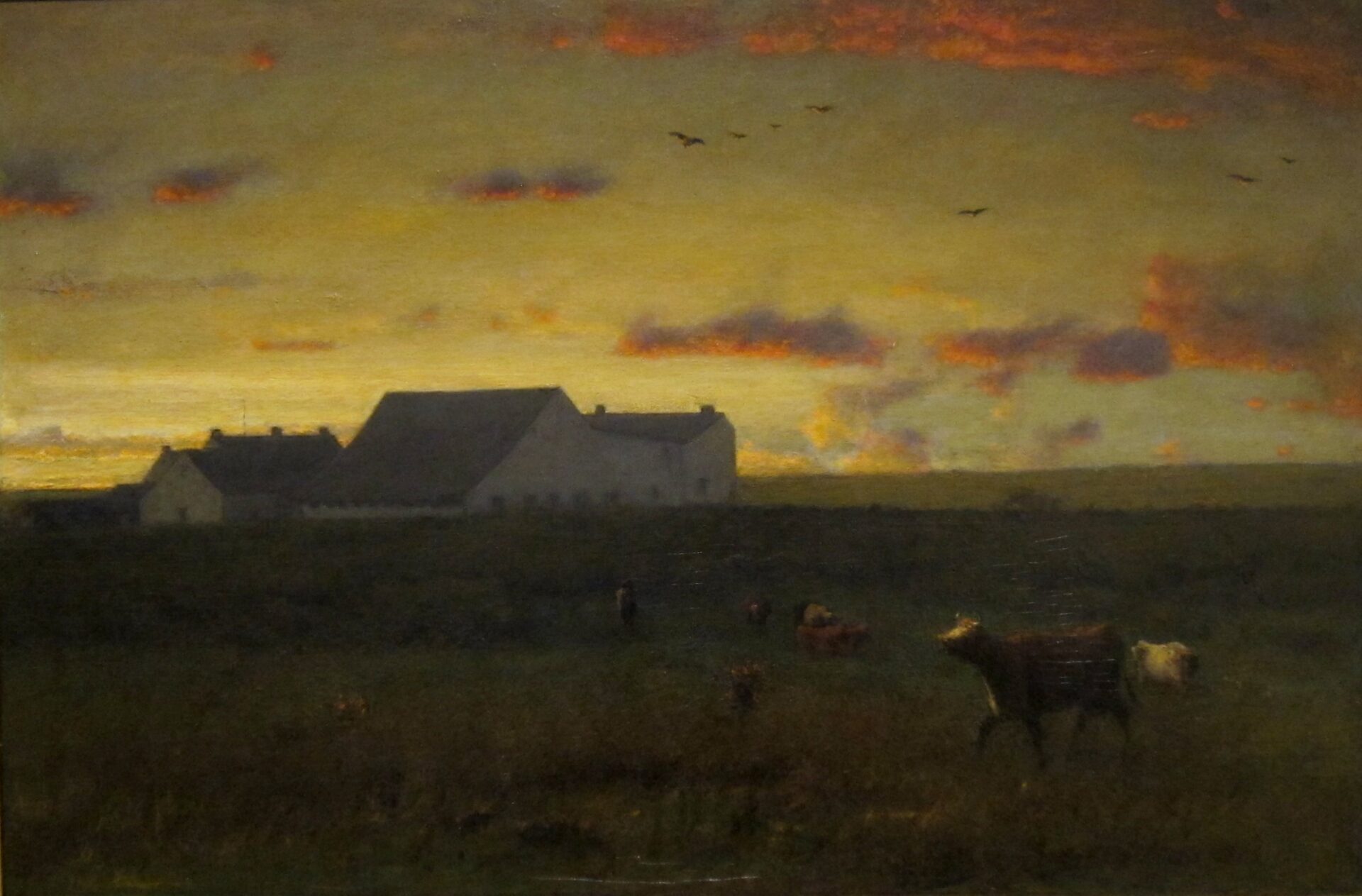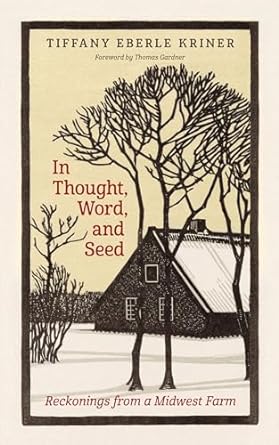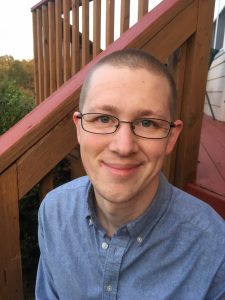Point Lookout, Missouri. I read most of Tiffany Eberle Kriner’s In Thought, Word, and Seed on an unseasonably warm November afternoon. It was too warm to work in my office, and so I decamped to the courtyard, sprawling in a deck chair outside the door of the college library, my laptop and its load of emails and student papers cast aside. I heard leaf blowers running around the corner, close enough to make their presence known but far enough away not to intrude on my concentration. A squirrel dashed back and forth across the courtyard, taking refuge under low evergreens in a berm. Sparrows flitted in and out of the building’s facade, with one—maybe a field sparrow—alighting briefly on a wall near my seat. Students and colleagues, some whom I knew and more whom I didn’t, passed by on their way in and out of the library. As I read, my mind revolved around some worries, anxiety barely surfacing to my consciousness. A friend walked by, and we exchanged a few words. I came to the end of the book just as my workday came to an end and shadows began to consume the courtyard. I gathered up the book and my disregarded laptop and began my trip home.
Like Kriner, I am an English professor with agricultural pretensions. We’re not an uncommon type, as the digital pages of FPR will amply testify. And yet it’s a combination that introduces certain difficulties. Farming well asks one to be a placed person, but a role in the professoriate requires mobility. Faming well involves one in creating a local, low culture, but English professors too often serve as priests of an international and deracinated high culture. Farming well requires attention to one’s physical surroundings, but work as an English professor tends to direct one’s attention insistently to “the life of the mind.” As farmers and gardeners, as neighbors and friends, we live in the world, buffeted by emotion and touched by the weather. As professors, too often, we feel our only job is to read.
Kriner investigates these difficulties in her first chapter, which reflects upon the meanings of the word “field”: “I wasn’t sure I was cut out for having a scholarly brand at all. But I was trying to get into the field.” In Thought, Word, and Seed is Kriner’s second book; her first, titled The Future of the Word, developed a metaphor of reading as cultivation. “But,” Kriner comments, “I realize now that I hadn’t thought as much about where books might be cultivated, and whether and how it might matter if they were cultivated in one place rather than another.” If English literature is a scholarly field, it is not—or at least not as readily—a “home field, a place in the world.” At least, not as it is commonly practiced. Often, to study English literature is to be displaced, homeless, rootless.
Such rootlessness in the study of English literature is not just a spiritual burden upon individual scholars but a practical threat to the future of the discipline. With higher education in America entering what will likely be a prolonged period of contraction, humanities departments and entire institutions need to pursue unique purpose, not conformity. Too frequently, individual scholars and academic institutions act as if the key to their survival is playing it safe—holding narrowly to scholarly trends or desperately imitating peer institutions. What such scholars and institutions never seem to ask is why a student entertaining a myriad of options should bother to study with a professor or a scholar who’s striving to be just like everybody else.
In English literary studies particularly, the discipline has long been searching for a new sense of scholarly purpose. After the heyday of literary theory in the 1980s and 1990s, no new project has really emerged to animate the field. Interests in digital media and textual studies arose but never really grabbed hold of literary studies wholesale. Today, the overwhelming interest is race—and while that’s a critical subject matter, only the most zealous idealogues think it’s sufficient to animate the entire scholarly field of literary studies.
Accordingly, I would contend that scholars of English literature would do well to follow the example of Kriner’s In Thought, Word, and Seed, and give more attention to where books might be cultivated. Not every text submits to concerns with digital media, textual experimentation, or even interrogation in terms of race—but every text was written in a place. Moreover, however much we might ignore it, every literary scholar lives in at least one place as well. Attending to these facts might offer our discipline a new sense of purpose. Critical interrogation of texts is ultimately parasitic; it was destined to burn out. To explore what it means to read a book in place, though, is a creative act, and one that can help us find ever more meaning in rich texts, those classic works that Kenneth Burke proclaimed “equipment for living.”
Given my claims that literary critics must read in place, I ought now to turn to examining what it meant for me to read In Thought, Word, and Seed on a warm November day in rural Missouri. The preceding reflections, of course, arose out of this place and this text. But these reflections on the state of criticism are only a sort of promissory note, thoughts occasioned by the book rather than examination of the book in place itself. Let me turn now to a closer reading in place.
There’s much I learned, and much I could say, about the five lyric essays that make up the book. In probably the most memorable essay, the second chapter entitled “Grass,” Kriner reflects upon her experience living in rural Illinois during our recent racial turmoil, in the form of a series of letters to James Baldwin. “Clearing” recounts Kriner’s encounter with an injured owl in her woods, interweaving that narrative with commentary on the Romantic poets, the Psalms, and the aesthetics of Elaine Scarry. The concluding essay, “Wattle,” examines the idea of the holy with reference to Charles Taylor and Robert Frost. Each essay repays close attention with lyrical prose and new insights into the texts Kriner investigates.
On that warm November day, however, the opening essay, “Field” struck me most. I have already made allusion to that essay in my examination of how Kriner’s book recasts literary studies, but it’s worth saying more now about the how reading “Field” affected me, in my place—about how it equipped me for living here. “Field” examines Charles Chesnutt’s African American dialect story, “The Goophered Grapevine,” as well as commenting upon how Kriner and her husband came to settle on a degraded farm in northern Illinois. “The Goophered Grapevine” is set on a postbellum grape plantation in North Carolina. The narrator, John, and his wife are a white couple from northern Ohio who need to move south for her health and so are considering purchasing the abandoned plantation. As they walk the land to appraise its value for their purposes, they meet a former slave named Uncle Julius who has been squatting on the land since it was abandoned. Uncle Julius tells them the land is “goophered,” or cursed, and relates the story of the goopher, in which a slave named Henry’s life was supernaturally tied to the fate of the grapevines—when they put on leaves and fruit he grew strong, but when they shriveled with the onset of winter, his health declined. With Henry’s death, the vines too lost their potency, and so Uncle Julius concludes: “En I tell yer w’at, marster. I woud n’ ‘vise yer to buy dis yer ole vimya’d, ’case de goopher ’s on it yit, en dey ain’ no tellin’ w’en it gwine ter crap out.” Despite this warning, John buys the vineyard and finds no evidence of the goopher, but rather observes that the vineyard “has been for a long time in a thriving condition, and is referred to by the local press as a striking illustration of the opportunities open to Northern capital in the development of Southern industries.” As the story closes, he speculates:
I found, when I bought the vineyard, that Uncle Julius had occupied a cabin on the place for many years, and derived a respectable revenue from the neglected grapevines. This, doubtless, accounted for his advice to me not to buy the vineyard, though whether it inspired the goopher story I am unable to state. I believe, however, that the wages I pay him for his services are more than an equivalent for anything he lost by the sale of the vineyard.
Kriner notes that for many years, she taught Chesnutt’s story as a trickster tale. Rather than seeing through Uncle Julius, John has misunderstood him: the old man gets what he wants by obtaining employment on a working vineyard. As she begins thinking about the story in place, though, Kriner grows uncomfortable with this neat reading, which seems to cast Chesnutt himself as something of a trickster, pulling one over on his readers. She proclaims: “I need to let [Chesnutt’s] stories look in my direction; I need to let them come by here.”
To that end, Kriner pursues a new reading of “The Goophered Grapevine” as a “cautionary tale for eager-beaver newcomers to the neighborhood of the plantation.” With this approach, the story begins to illuminate the difficulties and complexities of living life in place. Examining Chesnutt’s life history, she notes that he himself moved in search of economic opportunity, though his move was the precise opposite of John’s—from North Carolina to Ohio. However, Chesnutt’s uprooting had to do not just with economic opportunity but was endowed with broader purpose as he sought to write fiction that would promote interracial community. Kriner quotes his own statement of his intentions:
The object of my writings would be not so much the elevation of the colored people as the elevation of the whites—for I consider the unjust spirit of caste…a barrier to the moral progress of the American people, and I would be one of the first to head a determined, organized crusade against it.
Accordingly, Kriner describes Chesnutt’s uprooting as “a necessary exodus toward a promised land,” undertaken in the hope of Blacks and whites “making a culture together.” Hence she concludes that “not only the need for a home but also a home field, a place in the world, is behind the stories.”
What then of letting Chesnutt’s cautionary tale “come by here,” letting it speak to Kriner’s own settling into place? Is her own relationship to place an exploitation or an exodus? Answering that question is complicated, as suggested by Kriner’s subtitle, which describes these essays as “reckonings.” Kriner notes that she and her husband bought their property, now called Root and Sky Farm, hoping to found a “just food farm,” aspiring to “build welcoming, diverse communities of neighbors, farmers, and artists.” And yet their accomplishment of these lofty goals, naturally, can only be partial. More, Kriner recounts, their first visit to the farm puts the realization of these ideals to question. Kriner and her husband bought the farm as a foreclosure, and so the first day they walked the land the previous tenants were still in residence. While Kriner tries awkwardly to strike up a relationship with the tenants, they shake her off in hostility, insisting they “got nothing to do with this place.” After the bank evicts them, they leave the house full of trash and Kriner full of internal conflict: “It’s necessary to know who will prosper in a field, and why. And what happened before. And what all the hidden forces are that bear on prosperity and harm.”
As I finished In Thought, Word, and Seed, those hidden forces were very present to my mind. Like Kriner and her husband, we moved onto a rural property in hopes of doing something good in the place, finding a home field. Unlike her, I found the hidden forces—of my own anxieties and limitations, of the geography and development patterns of the place—to be too much for me. As I write, I’m in the midst of making my own necessary exodus from a property about which I always had some doubts, moving into town and closer to the college campus where I carry out my work as an English professor—and where I finished Kriner’s book on a warm November day. If I am therefore departing one field in which I hoped to do some good work in place, I hope to deepen my practice as an English professor who lives and reads in place, bringing my reading and my other work in the world closer together in the most literal, physical sense. For encouragement in my pursuit of that home field, I have Tiffany Eberle Kriner to thank.
Image Credit: George Inness, “Farm Landscape, Cattle in Pasture” (1883) via Wikimedia Commons





